
Release: 21-01-2015
- passback
- new creative template
- change from UCTR to CTR
 Passback
Passback
Overview
AdOcean allows you to use passback-enabled creatives, which may be used to request ads from external adservers with the possibility of emission return when an external adserver can't serve any ads.
How does it work?
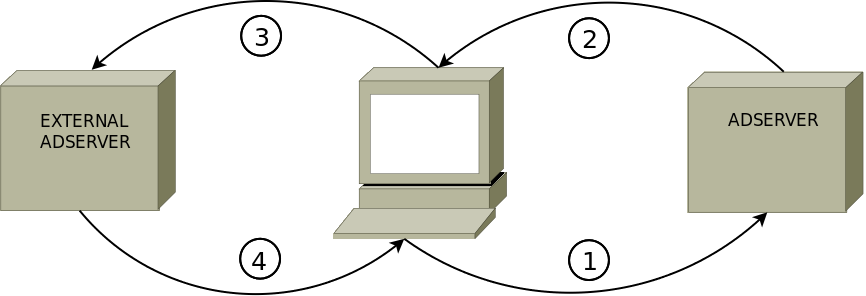
- Website makes a request to an adserver for an ad using placement script.
- The adserver sends a passback-enabled creative with an attachment of the best alternative creative to be displayed on passback call.
- Website makes a request to the external adserver using an external ad script defined in the passback-enabled creative.
- The external adserver doesn't have a desirable ad, so it returns a passback code. The best alternative creative is displayed.
Requirements
Client placement codes must be deployed with:
Creating Passback Enabled Creative
- Create a new campaign, set basic campaign properties like publisher space.
- Set a new creative. Choose the Passback Enabled Creative template.
- Set Passback ID, which will identify which passback is executed by an external AdServer ("970x100" in example).
- Insert the external ad script into the JavaScript code field.
- Create other campaigns on the same publisher space with optimization based on ECPM.
Example screenshot:

Configure external AdServer
Check external AdServer documentation how to set a passback code for AdUnit.
Passback code differs depending on scripts generated by an external adserver. If the external adserver uses iframes or frames, see Alternative Passback Code. Otherwise use the standard passback code.
Passback code
Standard javascript passback code:

Where '970x100' is a value of the passback ID parameter filled in the Parameters section of your passback-enabled creative.
If the HTML passback is required, envelope JavaScript in the script tag.

Alternative Passback Code
If you call passback between frames or iframes, the following code should be used:
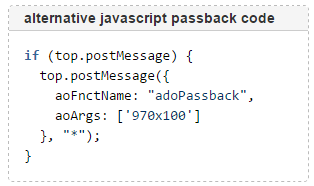
Where '970x100' is a value of the passback ID parameter filled in the Parameters section of your passback-enabled creative.
This code may be used without frames and iframes, but has some limitations. Microsoft Internet Explorer older than 8.0 and some other very old browsers do not support interframe messaging.
Creating alternative campaigns to be displayed on passback call
AdServer, after choosing the passback-enabled campaign for impression, chooses "the best alternative campaign". This campaign will be shown if the impression was not used by the external adserver and callback have been called.
It must meet several requirements:
Alternative campaign properties:
Warning: All campaigns that can be chosen as "best alternative campaign" for passback enabled campaign can also be chosen like all other campaigns in the system without passback.
Passback-specific statistics
In the Statistics view in the RTB summary section, the number of impressions in the AdServer column shows how many times a particular impression has been returned to the AdServer using the passback code.

Other fields are not filled when Passback Enabled Creative is used.
Preview limitations
Passback Enabled Creatives are visible in Preview and Live Preview but no alternative campaigns from the AdServer are presented (only external AdServer emissions).
Current version limitations and future improvements
 New Creative Template – MultiAd
New Creative Template – MultiAd
Thanks to the MultiAd creative template it is possible to display creatives from various campaigns on one placement at the same time by dividing the available advertising space between „small ads”, or to display only one creative that occupies the whole available space. The ads can be displayed vertically or horozontally.
AdOcean decides first whether to display one big creative or several smaller ones. In the second case, the system automatically selects the appropriate number of smaller ads and at the same time makes sure not to exceed the size of the placement. Each of the displayed ads is measured independently and has its own statistics.
MultiAd has 3 forms:
- text ad
- graphic ad
- text-graphic ad

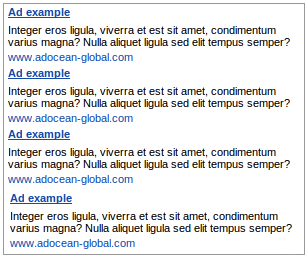

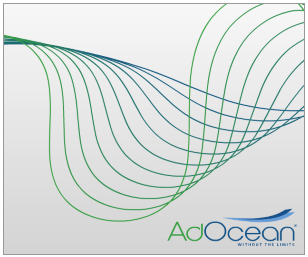

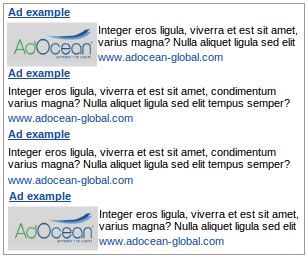
 Change in default values in the AdOcean interface
Change in default values in the AdOcean interface
Default values presented in the system have changed. CTR (click) are now presented instead UCTR (successful click). The changes are visible in the following Rankings: flights, websites, placements,placement categories creatives, creative categories, detailed, Geo stats: regions, cities/towns, and Tech stats: web browsers, operating systems.
UCTR have been removed from the default view:
Basic: Reach, Expansions, UExp, Other UC, All UC, UC, SUC.
Advanced: UA, UA-pc, UA-pv, UCTR, UCTR d.i., CR-U, AR-U, TTExp, TTC, TTA-pc, TTA-pv
Frequencies: Frequency
UCTR statistics are still available, however, appropriate check boxes in different views need to be checked in order for them to be displayed.
